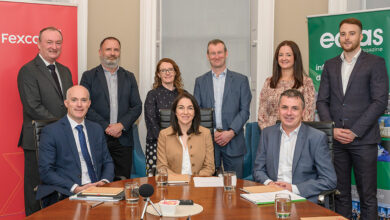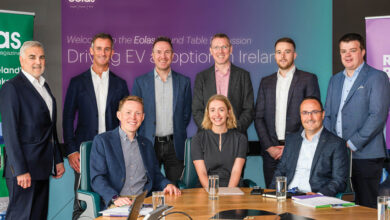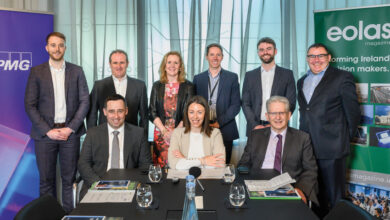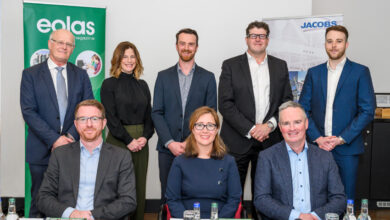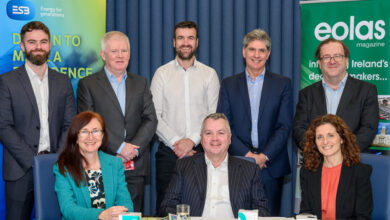Developing Ireland’s offshore wind resources
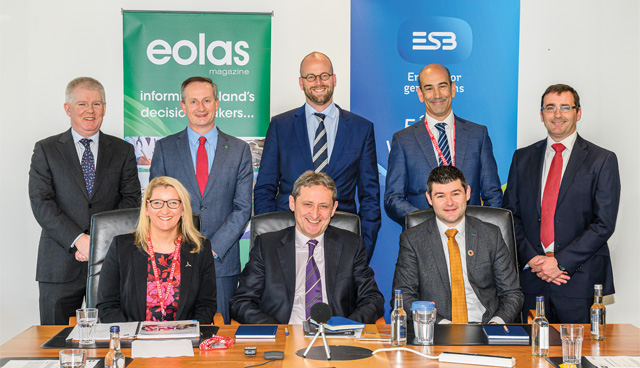
ESB hosted a round table discussion, bringing together stakeholders from the public, private, domestic and international offshore wind markets.
What is the potential of Ireland’s offshore wind resources? What are the benefits of realising this potential?
David Connolly
There was a blanket assessment conducted by the SEAI in 2010 where it looked at what was the offshore resource in terms of gigawatts. At that time, they put a figure of 30GW on it, but I would say that in the decade since, there have been two huge developments. One is the scale of an individual wind turbine offshore has multiplied dramatically to the power of two or three times when compared with back then. The second is floating offshore wind which has meant that the depths we can enter now are much further away than previously thought. That 30GW is probably an absolute minimum.
Matt Collins
The opportunity is enormous and yet to be calculated. This demonstrates that we need to, and will this year, begin a process of undertaking a new Offshore Renewable Energy Development Plan assessment to get a real idea of what the potential is. Thinking about it, if you look at the ‘real’ map of Ireland, which is where Geological Survey Ireland has mapped the seabed, it is 10 times the size of the island. That gives us some idea as to what the potential might be.
In the long term, we should be thinking of the Irish region as an energy source for Europe and not merely as part of the Climate Action Plan.
Peter Caluwaerts
I would like to start by making a comparison with Belgium. Belgium has 63km of coastline and by the end of 2020, there will be over 2,000MW of offshore wind developed with an additional 2,000MW coming up. If I am not mistaken, Ireland has over 3,000km of coastline. I think that speaks for itself on what the potential is for Ireland. In relation to benefits, on the one hand, there is the production of green energy of course, but there’s also a whole industry associated with offshore wind. In Belgium where we are now roughly over 10 years into offshore wind development, recent calculations indicate that in that decade, between 15,000 and 16,000 direct and indirect jobs have been created. This is not only in construction but also in the domains of research and development, operations and maintenance.
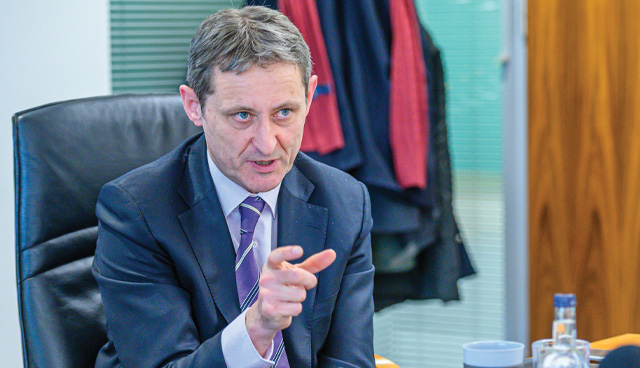
In terms of export of power, Ireland has historically been an importer of power. There is potential to change the dynamic, both economically and also in terms of Ireland’s position relative to interconnection.
— Jim Dollard
Jim Dollard
It’s a huge opportunity for the State and the adjectives already used in this discussion – vast, massive and huge – are accurate. There is a very large and, as yet, untapped resource off the coast of Ireland. It’s an exciting time for our country. In terms of the benefits, I think the Climate Action Plan will be delivered and post-2030, the question posed is ‘should we be doing more’? In terms of export of power, Ireland has historically been an importer of power. There is potential to change the dynamic, both economically and also in terms of Ireland’s position relative to interconnection.
Úna Brosnan
Our energy system is heavily influenced by an energy trilemma and we are on the cusp of needing something transformational in the Irish economy in the energy generation space Offshore wind is a must. The two biggest commodities in the next decade are going to be water and electricity. Offshore renewables could address both sides of this business case, especially energy security in the context of the decommissioning of some of the fossil fuel stations in 2025 and 2028 – we are going to need something at capacity to fill that gap. The potential is evidently there, as is the relevant skillset in the Irish economy. While fabrication and installation would bring some challenges, there is a lot more to tap into – from quayside operations, port infrastructure and smart technologies, to operations and maintenance.
Jim Arigho
From a funder’s perspective, the asset class has got a strong risk profile, it’s long-term and it’s well understood. From our point of view, our experience has been very positive in the energy sector. In terms of regulation, we need a system that is rational and consistent. That will facilitate investment in the sector and the opportunity then is huge. When you’re talking about gigawatts, you’re talking about investments in the billions of Euro. The financial appetite to support such growth exists within the financial markets which means that there should not be a problem in funding even 30GW or above in the future. That being said, we should move quickly while we have an incredibly low long-term interest rate environment and we cannot be sure when this might change.
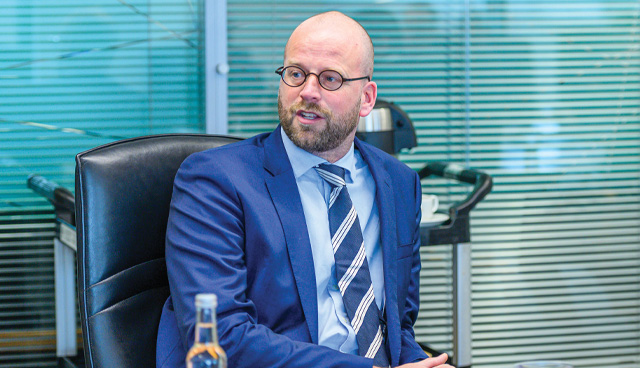
Obtaining financing for offshore wind projects used to be a big challenge and now banks are lining up to finance projects. It is an excellent time to scale up. All the conditions are there.
— Peter Caluwaerts
Leo Clancy
It is essential first of all that we unlock enough wind to hit our targets for 2030. That is our first big milestone and I think offshore wind has significant potential to contribute to that. In terms of the benefits, from an IDA perspective, in any sector where we have an abundant natural resource, we’ve done very well.
If you take the 450GW potential across Europe, work out what Ireland’s share of that is and then set out a credible plan, we have the potential to attract a lot of the global supply chain for wind into Ireland. Similar to our experience with data centres, if we can capture that supply chain early and unlock the potential to service Europe. We often find it difficult to be relevant in certain industries, but as an island on the fringe of Europe, wind is an area in which we have a significant competitive advantage.
How will offshore wind contribute to meeting the 70 per cent of electricity by renewables by 2030?
Jim Arigho
While the 70 per cent target refers to electricity, our challenge in Ireland is much bigger than just electricity. It’s electricity, heat and transport. The big lift will be the electrification of heat and transport. That 70 per cent then becomes 70 per cent of a much bigger number. One of the bigger challenges with offshore will be absorbing all of that electricity when generation is at its peak. Transport and heat are part of that answer. We have to put in the infrastructure that enables heat pumps and electric vehicles and converting that electricity into hydrogen for use in transport and elsewhere. It’s key that we use that 70 per cent as a guiding light but it’s about us hitting our Paris Agreement targets also.
Jim Dollard
It’s 3.5GW of offshore along with 4GW of onshore wind. Those targets roll off the tongue, but that’s a lot of energy to be delivered. You’re talking about doubling peak capability. It’s not an insignificant challenge but it can be done. It will require technology, regulatory clarity, and there is something else that we are all aware of too. This is a different community from the ones that we have previously dealt with. These are coastal communities, fishermen etc., and we are going to have to interact with them in a proper fashion to allow this industry to develop. They will be really key stakeholders, as we know from onshore wind. If you don’t engage correctly, it will be a big problem. You might get your project off the ground, but you’ll sour the industry. We need to make sure we start that community engagement well and build on it.
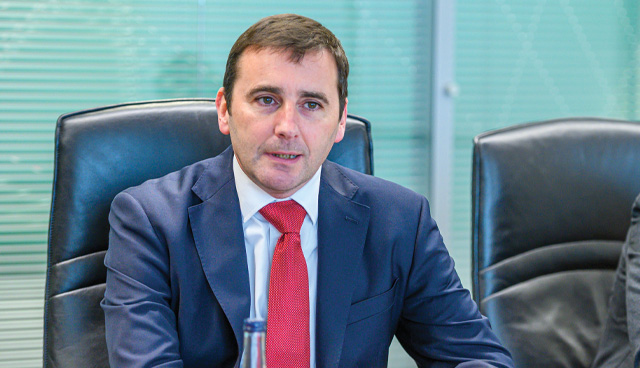
I think it’s important that we don’t think of the Climate Action Plan as some massive, centralised plan. There will be variability. If offshore wind is able to deliver more than 3.5GW, all the better.
— Matt Collins
David Connolly
The currency we are all dealing in is carbon. The ultimate goal in the Climate Action Plan is to get carbon emissions down by 16 million tonnes a year across all sectors. The 70 per cent renewable electricity target will account for between seven and eight million tonnes of that. It is vital we get the other sectors on board, but the 70 per cent target is fundamental to the whole Plan being a success. The core of that 70 per cent is the 3.5GW of offshore wind and the 4GW of onshore, so you could look at it as saying that a quarter of the Plan is offshore being a success. We are ultimately trying to reduce carbon emissions and offshore clearly has a significant role to play in that journey.
Matt Collins
I think it’s important that we don’t think of the Climate Action Plan as some massive, centralised plan. There will be adaptability as costs and technologies evolve. If offshore wind is able to deliver more than 3.5GW, all the better. We will be led by the projects but it’s important that we have the right framework in place that allows the projects to evolve.
Jim Arigho
Offshore opportunity is so big and 3.5GW in the global offshore market actually isn’t a lot, despite being worth billions in investments. If we want to have a supply chain with roots in Ireland, that is efficient, it makes a lot more sense to give the line of sight of a bigger opportunity. Whether or not we are going to build more often influences the design of a project. We need to indicate that there is a big opportunity here for the offshore industry to put global roots down in Ireland. That will be key to getting employment here and bringing down supply chain costs.
Peter Caluwaerts
The big advantage of offshore wind is the sheer scale that can be developed nowadays. Our first project we developed over 10 years ago was 165MW; if you look at it today, that’s really small in terms of offshore wind development. It’s the scale that has developed over 10 years, both in project size as in turbine size.
What are the main challenges for developing offshore wind?
Úna Brosnan
There have been a lot of lessons learned as the industry has developed in the UK. Echoing policy and putting a strong framework in place to support offshore wind projects will be essential to starting the Irish market off right. In the UK we experienced a stall in the industry due to policy challenges and cost reduction which has an impact on fabrication and wider supply chain productivity. Amber Rudd laid down the gauntlet in 2015 and challenged the industry to a cost reduction. About 10 years ago, the cost was £140 per MWh, in 2016 it came below £100 for the first time, and presently sits below £40 post-2019 auction round. Initially the industry underestimated the impact of low interest rates on the business model, and this has been instrumental in realising projects. In terms of volume, there is a prospective 3.5GW for Ireland but we should strive for a larger pipeline. Infrastructure wise, one of the biggest challenges is ensuring we have a strong business case and investor confidence around each project. It’s hugely important to liaise with counterparts in the UK in that respect — absorbing the industry development challenges and truly understanding what has and hasn’t worked. Stakeholder engagement is essential along with understanding cumulative effects or lack thereof which has seen four projects in Scotland effected. We need to learn from those lessons and have an evidenced based approach to ensure we get it right first time. As seen in the recent UK auctions, volume gets you buying power which has been essential in realising cost reduction for some of the latest sites. We need to be smarter about how we shape this, not just from a technological and engineering perspective, but from a business one.
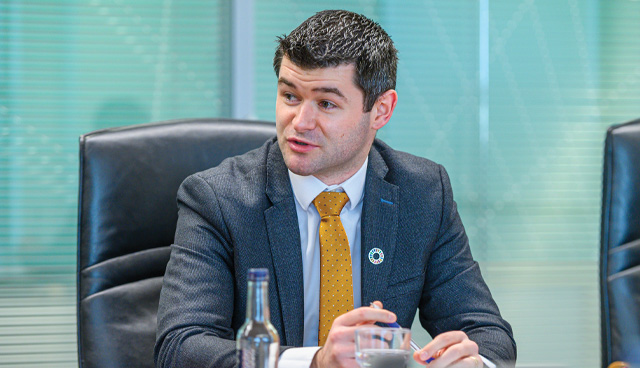
We talk about 2030 and think of it as a long way away, but in the context of the development of a project, it is basically tomorrow.
— David Connolly
Peter Caluwaerts
Obtaining financing for offshore wind projects used to be a big challenge and now banks are lining up to finance projects. It is an excellent time to scale up. All the conditions are there. Of course, you need a supply chain that matures, but that comes quickly once there is an outlook of a certain volume amount.
Jim Arigho
Building a supply chain is key. When we look at offshore, the initial Irish projects will be more expensive than the, say, £40 per MWh mark currently achieved in the UK but they initially paid up to circa £140 per MWh. If, because of the future opportunity in Ireland, projects can happen in such a way that embeds the supply chain here, and projects are maintained locally then hopefully the required strike price will come down faster.
Peter Caluwaerts
Although the industry has matured, building offshore wind still is not an easy thing. It’s a complex process with different challenges, such as technical, financial, legal, permit, environmental and grid challenges. Offshore construction is very different from onshore construction. You need careful planning and preparation. If somebody forgets, let’s say, a screwdriver that is needed to execute work offshore, a whole crew has to go back onshore to get it. It costs a lot if you forget even something as insignificant as a screwdriver during offshore construction. The biggest challenge however for each developer is still regulatory stability.

Stakeholder engagement is going to be fundamental to the success of this industry – get down to the grassroots, go into schools, local communities, those by the coast, potential supply chain partners and educate people about the opportunities and benefits, and encourage public support.
— Úna Brosnan
What changes need to be made to the regulatory and planning frameworks for the sector?
David Connolly
The one thing I flag every time I talk about offshore and planning is time. We talk about 2030 and think of it as a long way away, but in the context of the development of a project, it is basically tomorrow. We are under severe time pressure as it is and when it comes to policy framework, it’s the same three pillars you talk about for any project: planning, financing and grid. In Ireland, we’re at the very beginning of that. One thing we’ve done in the past is thought about these things as sequential steps, I think we’re going to have to do them in parallel if we have any chance of getting there on time. We can’t wait on one project to finish before the next starts.
Jim Dollard
Firstly, the legislation needs to come. We need clarity on that. That legislation is going to be really important; the auctions depend on it. Until that clarity comes, you’re not going to see progress in the industry. The industry is effectively waiting right now, but we understand that the legislation is developing. Managing the relationships with the communities will be very important for the industry and the grid will also be important. If you look at what’s required to develop any industry project, you need the regulatory framework, planning infrastructure and grid. The east coast of Ireland looks quite promising in terms of grid, but 3.5GW is going to test us in that context in the timeframe we’re talking about and if we’re talking about beyond to the west coast, 2030 is tomorrow as David said. We need to start thinking about that now. The availability of grid is always a key ingredient for all projects.
Matt Collins
A key goal for us is delivering on the 70 per cent renewable electricity target, then we’re talking about delivering on onshore, solar and offshore. The balance can change but the key challenge for us is those three pillars. We have to get the development management permitting system up and running; we have proposed legislation, the Marine Planning and Development Management Bill and that’s an absolutely priority for us that we’re actively working on. The transition protocol needs to be in place to allow the first phase of early projects to proceed. We have discussed with CRU in terms of incorporating the need for that scale of project developments into grid assessments as well. We have no choice about doing one bit and then another, we have to move ahead on all fronts. That’s critical in terms of getting the early phase of projects that are in preparation. The second pillar is the grid development and that is hugely important. Grid development will be hugely challenging for that 70 per cent, not just for offshore but for all electricity. We need to move towards a more planed grid development, particularly in offshore. There are valuable resources on our shoreline, and we have to manage them in the right way to maximise the number of offshore projects that can be developed. We hope that EirGrid will have a grid options paper completed this quarter and that’s going to be the platform for key decision making in terms of how grid development will proceed. In terms of the route to market, that’s probably easier to do because other countries have done it, there are established models to follow. We aim to do our first RES this year and we have a view to have the offshore RES ready for quarter two 2021. The development of that regulatory system is important, in terms of providing a predictability and so communities can have confidence in the regime and legitimate concerns are being taken into account. That makes it tougher for projects, but it also makes projects more reliable. Strong consenting systems are important. In other sectors, the social license has been eroded and we need to make sure that we do things in a way that is accepted and endorsed by the community. We can’t do a quick job on the regulatory framework; it has to be done well.
Jim Arigho
It’s an indication of the challenge of regulation when you’re spending much more money on legal costs than on ecology and environmental studies to deal with permitting issues. If the regulations are science based, investors can assign probabilities and weigh the risk, it’s when something is unpredictable because you’re arguing about a legal interpretation that financiers get frustrated. It’s not easy to do, but we need to work hard to get regulations that are as consistent, equitable and rational as possible.
How do we ensure the development of an adequate supply chain for offshore wind in Ireland?
Leo Clancy
I think we need to ensure that there is a good regulatory framework in place for the industry in the long term. For any of our investors, the table stake is that Ireland is competent in a given sector. Beyond that, the job of the IDA is to win significant portions of global supply chains in various industries. We have less of a play today in the global energy market, particularly in wind and offshore renewable energy. However, there are Irish people spread all over the world – case in point being Úna – who are leaders in their industry. There is huge potential for us to do more, but starting early is key, as is being connected with other people around the table, as well as having a critical mass of future development opportunity to bring the supply chain here.
David Connolly
We have looked at the 25 per cent of potential that we can capture right now and then how we can consolidate this over the next five to 10 years, beyond 2030. There are several short-term factors that we have identified. Firstly, picking a port on the east coast of Ireland that could be a strategic location to service an offshore renewables market. Secondly, taking inspiration from the UK, developing an enterprise zone around that particular port which could cluster together the companies that work in the offshore sector. Thirdly, ensuring local community buy-in by bringing jobs right to the heart of where the industry is being developed. Finally, upskilling our people to be ready to capitalise on offshore market opportunities.
Matt Collins
When I was in Scotland to see the launch of a very large offshore wind farm, I was struck by how energising it was for the local community. Speaking to these people, I heard how their families worked in industries that had gone into decline and now they saw offshore renewables as a real alternative for the future. There are coastal regions in Ireland that are facing socio-economic challenges, so this potential is really important. The simple way of exploring this is to consider how much value you retain and supply from within the country. The social aspect can be dynamic. If we got to the stage where we had a natural workforce and families involved with this sector, it could become self-reinforcing.
Jim Dollard
If we want to develop an adequate supply chain, a vision beyond 2030 will be required. The numbers we discussed earlier – 40 or 50GW for this island – are staggering. The energy grid couldn’t absorb that, and we would have to find totally different solutions. Ireland must be extremely ambitious and that means going far beyond 2030. We should outline a vision that will entice people to invest here. There is significant opportunity in centring upon coastal communities and building capability there. Garnering community support can ensure that the industry endures for decades. Is it likely that Ireland will develop an indigenous turbine industry? That’s difficult to see given where we’re at, though not impossible. In the service industry, however, there’s no reason why Ireland could not punch above its weight.
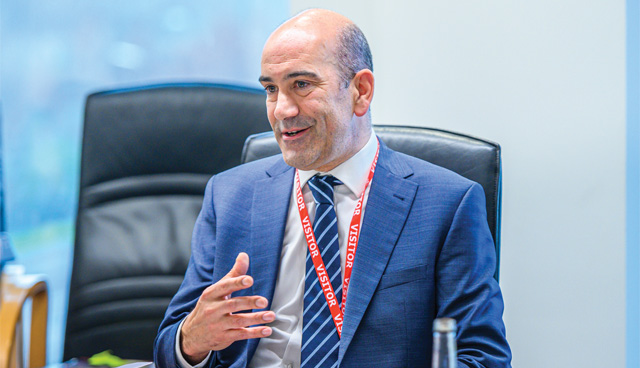
If we want to have a supply chain with roots in Ireland that is efficient, it makes a lot more sense to give the line of sight of a bigger opportunity.
— Jim Arigho
Úna Brosnan
The UK is the world leader in offshore wind, and we are seeing considerable development and acceleration of international markets. This is a huge opportunity for an Irish supply chain to find its place in the market. With that, Ireland needs to be mindful in this accelerating global market, as securing elements such as fabrication and installation vessels could prove a challenge. Stakeholder engagement is going to be fundamental to the success of this industry – get down to the grassroots, go into schools, local communities, those by the coast, potential supply chain partners and educate people about the opportunities and benefits, and encourage public support. An example of these activities was supporting school engagement in areas such as Fife in Scotland.
Peter Caluwaerts
It is important to develop the smaller harbours. People are often preoccupied by construction works and the large fabrication yards, but there are decades of work which come after this stage. In Belgium, we don’t build wind turbines for example, we import them. However, we create many jobs in the operations and maintenance sector, in research and development and our big dredging companies have all developed offshore wind activities. If you consider the Port of Ostend, a decade ago it was not attracting much investment, but when the port leaped at the offshore opportunity, it became Belgium’s offshore hub. The offshore maintenance companies have clustered there and attract local people into employment. There is a lot of opportunity and it is much wider than the mere construction stage of an offshore wind farm.
The Participants
Jim Arigho is a Director in the Energy, Climate Action and Infrastructure Team in Allied Irish Banks. Jim has been with AIB for over 13 years working in both Project Finance and Acquisition Finance. Jim has been involved in numerous Debt Financings including Onshore and Offshore Wind, Biomass, Anaerobic Digestion and Waste to Energy. Jim holds a Bachelor of Mechanical Engineering from University College Dublin and an MBA from the Smurfit Business School.
Úna Brosnan is the Business and Strategy Development Manager for Atkins Offshore Wind business and co-Chair of the Friends of Floating Offshore Wind. She is a Chartered Civil Engineer with over 18 years varied industry experience with the last nine-years immersed in developing and growing the global offshore wind business in Atkins.
Peter Caluwaerts is Project Director at Parkwind. Peter is responsible for the successful development and financial close of Northwester 2 (219MW) for which he is currently heading the ongoing construction works. He is also responsible for the development of the Irish Oriel project (330MW). After years of building extensive experience in large construction works, he started his career in offshore wind in 2010 by taking up the role of Chief Legal Officer of Parkwind, responsible for regulatory, legal and contracting matters.
David Connolly is CEO of the Irish Wind Energy Association (IWEA) which is Ireland’s largest renewable energy association. IWEA works with a wide range of internal and external stakeholders to build understanding and awareness of the benefits of Irish wind and renewable energy, and to ensure that Irish wind energy continues to provide clean, cost effective electricity to communities, businesses, factories and homes across Ireland.
Leo Clancy is a member of the Executive Committee of IDA Ireland. IDA’s mission is to attract foreign direct investment to Ireland, creating jobs and economic benefit for the people of Ireland. He leads the Technology, Consumer and Business Services sectors, comprising over 40 per cent of portfolio, as well as having responsibility for Corporate IT.
Matt Collins is the Assistant Secretary with responsibility for the energy function in the Department of Communications, Climate Action and Environment. He has responsibility for all areas of energy policy, including energy efficiency, renewable energy, electricity, energy regulation, and security of supply.
Jim Dollard is the Executive Director of Generation and Trading at ESB. Prior to this he held the position of Executive Director for Business Service Centre (BSC) and Electric Ireland. Jim was previously the General Manager of Electric Ireland. An accountant, he began his career in ESB in 1992 and has held a number of senior management positions throughout the Group including Acting Group Financial Controller and Financial Controller ESB Energy International.


